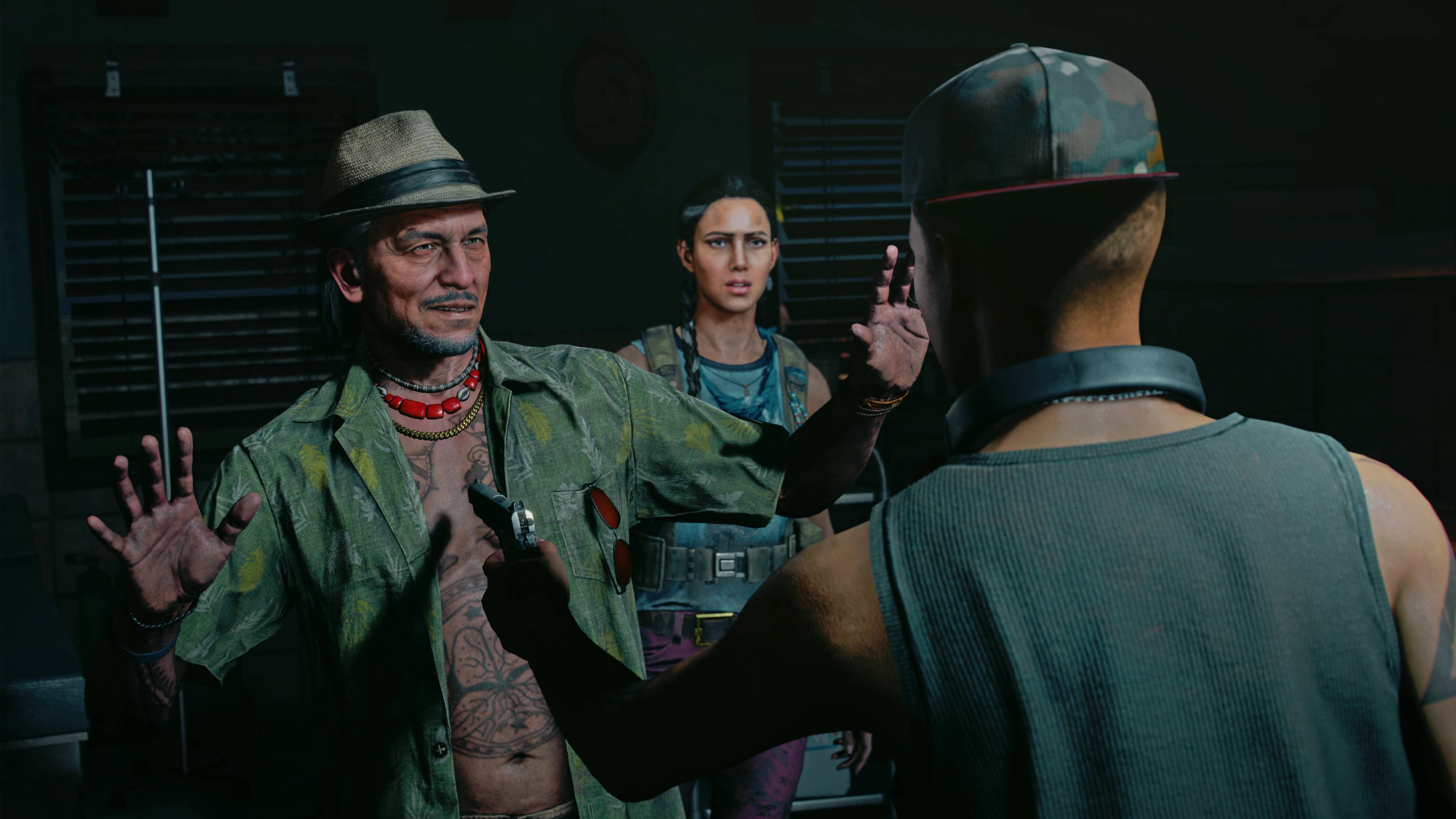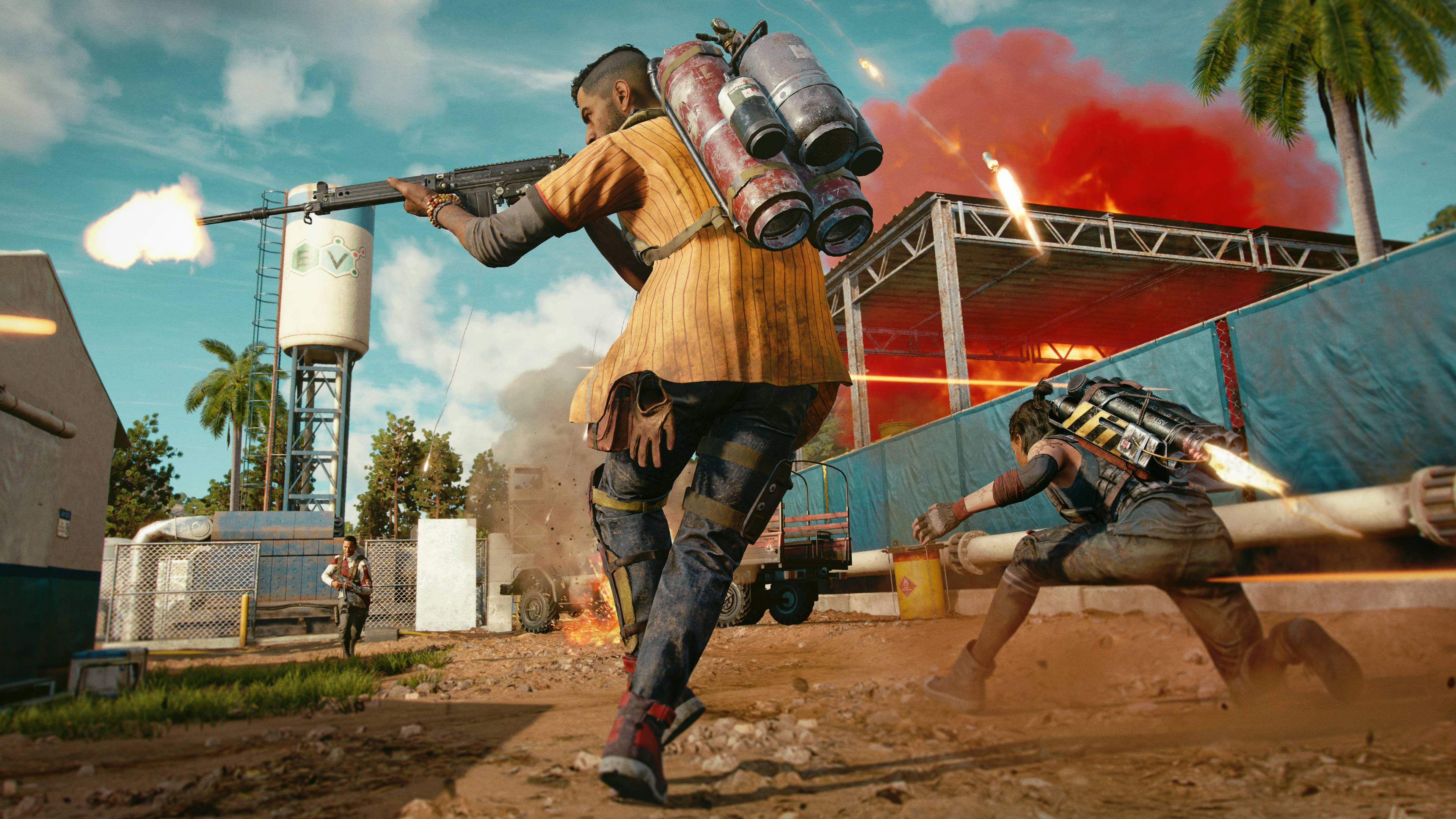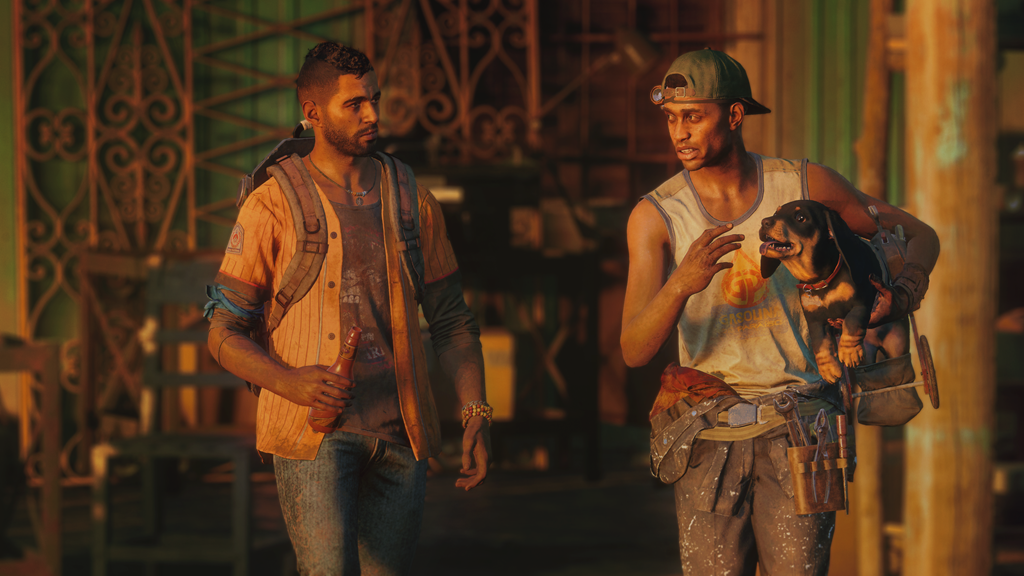The Far Cry series has been no stranger to controversy. From criticism over Far Cry 4’s cover art to the petition over Far Cry 5’s portrayal of religious fanatics as villains, Ubisoft’s long-running series is often contentious, to say the least, and Far Cry 6 is no different. Set on the fictional island of Yara, Far Cry 6 sees players taking on the role of Dani Rojas, who joins a guerrilla revolution against Yara’s tyrannical dictator, Anton Castillo (played by Breaking Bad’s Giancarlo Esposito). It’s a dark premise, but one that Ubisoft plans to balance with the chaotic, playground mechanics that the Far Cry series is known for – a balancing act that has already garnered criticism from some. So how does Ubisoft plan to earnestly portray a guerrilla revolution in a first-person shooter that boasts a weapon that plays the Macarena? We spoke to Far Cry 6 Narrative Director Navid Khavari to find out. Navid Khavari isn’t a stranger to Far Cry, having worked in a narrative capacity on Far Cry Primal and Far Cry 5, before becoming the Narrative Director and Lead Writer on Far Cry 6. So when it comes to knowing the key ingredient in a Far Cry story, he’s well-equipped to answer. There’s not simply one ingredient, Khavari tells us, but three: a charismatic charming antagonist, a sense of “David vs Goliath”, and a “balance of mature storytelling that isn’t afraid to tackle difficult themes – mixed with some levity”. But, with Far Cry 6, it wasn’t simply Anton Castillo that Khavari wanted to take center stage; instead, the challenge came in ensuring that the game’s guerrilla fighters were also the stars of the show–- characters that could go toe-to-toe with the unpredictable dictator and still stand out. “That's where I feel we're pushing the brand,” Khavari tells us. “We tried to make sure the revolution wasn't just this sort of homogenous entity, that you would have multiple different perspectives, multiple different motivations, multiple different types of personalities and characters you'd run into. So we wanted to keep those three things in mind, but really push Dani and the guerrillas in the story.” Yara is heavily influenced by Cuba and its own revolution, Ubisoft has admitted, but there has been criticism over whether Far Cry 6 can truly paint an earnest portrayal of such conflict – especially given the series is known for essentially being a humorous, chaotic playground. What’s more, Ubisoft initially shying away from the game being “political” didn’t help matters. It’s a similar approach that was taken with Far Cry 5, a game with a premise that was quintessentially political, but, in the end, merely dipped its toes in the pool rather than taking the full plunge. "We tend to see revolutions as black and white but they’re incredibly complicated conflicts and anyone who studies them will tell you that, so rather than tell a simple story with a binary point of view, we embrace that complexity." With Far Cry 6, it looked like the same approach was being taken. In an interview, Khavari claimed that the game is not meant to be “a political statement about what’s happening in Cuba specifically” that seemed to imply an apolitical approach was being taken once more. However, he later qualified his statements by saying that “our story is political” and based on “other countries around the [real] world that have experienced political revolutions in their histories”, but that the game was not a “simplified, binary political statement specifically on the current political climate in Cuba”. Ubisoft admits Anton Castillo, too, is influenced by real-life dictators from Cuba’s neighboring countries including the Dominican Republic and Nicaragua – as well as previous Far Cry villains. So how does that important element combine with the fast-paced, bombastic gameplay of Far Cry 6? Well, according to Khavari, Far Cry looks to represent both the heavy, dark elements of a revolution, alongside the bits that aren’t always serious. Nhavari explains that speaking to real-life revolutionaries, he was intrigued by how they found humor and joy in their high-stakes situations, recounting a story he was told about guerrilla fighters who would play music in the jungle before hiding them away when a military plane flew overhead. He says these moments feed into the experience too and keep it grounded, while feeding into the “DNA of Far Cry itself”. “We grappled with the sensitivity of the game from the beginning but it is important not to think about what we can or cannot say but rather what is the story that we’re trying to tell, to try to be fearless,” Khavari said in a roundtable event before the interview. “We tend to see revolutions as black and white but they’re incredibly complicated conflicts and anyone who studies them will tell you that, so rather than tell a simple story with a binary point of view, we embrace that complexity. “The beauty of telling a narrative about revolution is that, with a revolutionary group, there’s a mix of ideologies and perspectives that you want to capture. We don’t want to hide from the rise of fascism or what we’ve seen around the world, we wanted to talk about the effects of imperialism on an island like Yara, and the effects of blockades, and wanted to talk about LGBTQ+ rights within the context of the story. Incredibly important topics didn’t feel right to shy away from. “At the end of the day players will decide for themselves how we did and I encourage them to make their own opinion. We absolutely tried to approach the story with sensitivity and to not be afraid of sharing honest opinions.” In addition to Yara’s overtly political premise, it sounds like we may also encounter some more subtle references to the modern political landscape in the world. Far Cry 5 had some tongue-in-cheek Easter Eggs that referenced Trump’s alleged “pee-tape” and even Alex Jones’ rant on gay frogs, so I asked Khavari if we would see something similar in Far Cry 6. “What I will say is, if I were playing this game, having not made it, I would highly recommend going through it with a fine-tooth comb because there are tonnes of Easter eggs all over the place,” he coyly told us. “But I wouldn't want to spoil that for folks. Make sure you play the game, make sure you check all the credits and everything.” As Khavari says, LGBTQ+ rights are another important topic explored within the game, previously untouched territory for the series. “Without going into spoiler territory, we have numerous characters who identify as LGBTQ+,” Khavari tells us. “I think one of the things, speaking to experts and speaking to individuals on our team in consultation with experts outside of our team, we wanted to capture this idea of a revolution within a revolution. We have a character that speaks to that, that no matter what the bigger revolution of Libertad is fighting for, there is an ongoing revolution in terms of LGBTQ+ rights that wouldn't just end if Clara Garcia [leader of the Libertad] frees Yara. And that, in consultation with a lot of folks, we found really interesting and something that could be powerful to explore.” "At the end of the day, it's up to people to decide. I'm not presumptuous to say we did it right. I know we did what we felt was our absolute best." The inclusion of LGBTQ+ characters in Far Cry 6 is welcome – though we wanted to know how this topic was being tackled, particularly in regards to representation, as it’s something that we’ve seen poorly executed in games time and time again. “We wanted to represent our characters who identify as LGBTQ+ as folks that don't just identify their personality and who they are as LGBTQ+,” Khavari explains. “For example, we have a character called Rosa Mel Paquete, who is a drag queen who is gay. They're fantastic at the performance aspect of being a drag queen, but also, while they're performing for the military, they're secretly working for the guerrillas. We wanted to be as authentic as possible, as well, in how we approach these topics so we cast an actual drag queen in Toronto, Selena Vyle. “Also, in terms of representation, one of our guerrilla leaders, Paolo, is trans and we cast a trans masculine actor to try and represent that as well. I'm trying to say that we wanted to approach it with sensitivity and actually work with the performers to make sure they felt they were included in that process. Khavari explains that the team was aware of addressing any blind spots they may have missed with regards to representation throughout the game, including that of both the game’s LGBTQ+ and Latinx characters. But, following feedback from those who played early previews of the game, were there any that he felt had been overlooked? “No, not really,” he tells us. “I know the sort of work we put in over five years. So I know I can stand proud and confident of the work my team did and the time we spent. Again, I think we were really trying to push new ground in terms of the focus on authenticity, but come up with methods to have multiple checks throughout production. One of the things I was really concerned about was not to just do a check or talk to experts at the end when we can't change everything. We spoke to folks like Tanya DePass, of I Need Diverse Games and we spoke to Ana López, who's a professor of media and Cuban media at Tulane University, and even more. So I can stand by it. “At the end of the day, it's up to people to decide. I'm not presumptuous to say we did it right. I know we did what we felt was our absolute best.”
The pillars of a Far Cry story

Writing a revolution

Authentic representation

source https://www.techradar.com/news/far-cry-6s-narrative-director-talks-representation-revolution-and-a-return-of-gay-frogs/
Rule #21 of the internet: Original content is original only for a few seconds before getting old.


